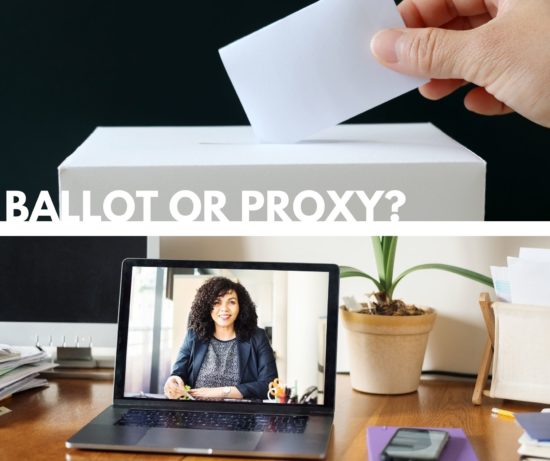
With annual meeting season upon us, along with the restrictions and complications attributable to the COVID-19 pandemic, and the need for associations to continue to conduct business, it is a fair assumption that many boards, managers, and homeowner are trying to figure out ways to take action without being physically present at a meeting. There are two ways for members to take action without needing to physically attend a meeting: (1) through the use of a proxy; or (2) through action via written ballot. While both present a viable course of action, they are not to be confused.
Proxies:
Proxies are used at meetings, including both in-person and virtual meetings. A proxy is: (a) a written document; (b) issued by a member of an association; and (c) providing authority of another individual to act on behalf of such member. The individual being appointed as the proxy-holder does not need to be a member of the association to be appointed. A proxy is only valid after it is actually received by the association.
There are two types of proxies, general proxies and directed proxies. A general proxy allows the proxy holder to make all decisions without direction from the member appointing the proxy holder. On the other hand, a directed proxy contains explicit directions to the proxy holder as to how to vote on various issues.
The proxy is a contract between the proxy giver (the assigning member) and the proxy holder. An association is not responsible for ensuring compliance with any directions contained in a directed proxy. A proxy may be revoked in writing by the proxy giver or by the attendance of the proxy giver at the specific meeting.
Proxies are beneficial as they allow for a fewer number of in-person or virtual meeting attendees while still allowing the association to meet quorum and to conduct association business. However, on the flip side, while a large number of proxies positively contribute to quorum requirements, a fewer number of members in the community, i.e. those actually attending the meeting (assuming the proxies are not directed), control the decisions being made.
Mail Ballots:
As opposed to taking action during a meeting, a mail ballot is used to take action outside of a meeting. In other words, there is no meeting (either physical or virtual) so the way the decision is made is by owners receiving a mail ballot and returning the mail ballot to cast their votes. Proxies are not necessary or applicable when taking action via written ballot as each member must be provided with a ballot and has an opportunity to vote without the need for having someone else vote for him/her. Additionally, the law makes it clear that proxies are only to be used with meetings and mail ballots are only to be used when taking action outside of a meeting.
Any action that may be taken during a meeting may be taken outside of a meeting by written ballot as long as all statutory requirements concerning mail ballots are met. When taking action by written ballot, every member must be provided with certain information regarding the proposed measure, such as a deadline for voting, quorum, and approval requirements, as well as any additional information that is necessary for an owner to make an informed decision.
Approval of a vote taken by a written ballot is based on the approval requirements as if the action were taken during a meeting. Unlike a proxy, a written ballot may not be revoked.
Confusion Between Written Ballots and Proxies:
Sometimes there is confusion surrounding the difference between proxies and written ballots. As stated above, proxies are utilized during a meeting, either in-person or virtually and a member is unable to attend. Using a proxy allows a member to be legally present at the meeting even though he/she is not physically (or virtually) present at the meeting. A proxy is not a ballot. A proxy only confers the right to take action on behalf of the proxy giver. Voting will occur at the in-person or virtual meeting and ballots will be provided to all proxy holders in exchange of their proxies.
Because there is no meeting when a mail ballot is used, “presence” for the vote is a moot point, and an owner is deemed “present” for the vote if he/she actually votes and submits his/her mail ballot. For this reason, proxies may not be utilized when conducting a mail vote. An action by mail ballot is separate and distinct from a meeting and should be treated as such.
Please contact an Altitude attorney at 303.432.9999 if you have any questions about ballots, proxies, or the difference between them.